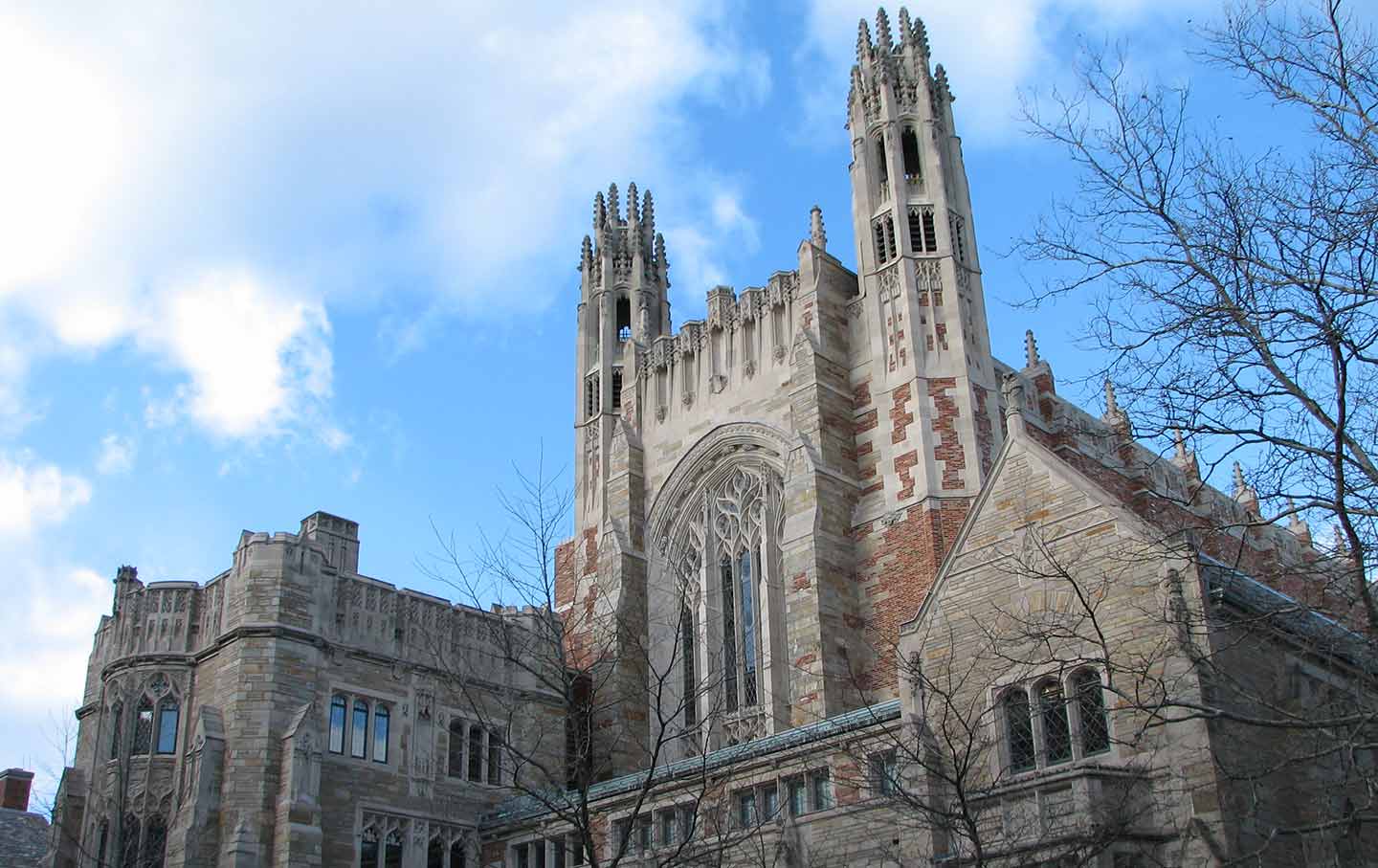
The Sterling Law Building of the Yale Law School.(Wikimedia Commons)
This was co-written by Yale Law School students Will Bloom, Wally Hilke, Bethany Hill, Amit Jain, Andrés López-Delgado, Maya Menlo, and Joseph Meyers.
In a recent opinion piece in Time, Yale Law School Dean Heather Gerken breathes a sigh of relief: Unlike the disruptive protesters at Middlebury and Claremont McKenna colleges earlier this year, her law students are trained to respectfully voice their dissent. “From the first day in class, students must defend an argument they don’t believe or pretend to be a judge whose values they dislike,” she writes. “The litigation system is premised on the hope that truth will emerge if we ensure that everyone has a chance to have her say.” She argues that this professional decorum is the most effective way to overcome division, reminding us that it was powerful enough to protect lawyers like Thurgood Marshall from violence during the civil-rights era.
Unfortunately, Dean Gerken’s article mischaracterizes both the protest that we and around 20 other students helped organize against Charles Murray in October 2016 and the treatment of civil-rights lawyers in the South. If anything, our legal training has taught us that civility has its limits, and that disruption, creative protest, and rule-breaking are valid and often necessary tactics to effect change.
Dean Gerken claims that civil-rights luminary and Supreme Court Justice Thurgood Marshall was able to practice law in small, segregated towns in rural Maryland during the early days of the civil-rights movement because “members of the Maryland bar had decided to treat Marshall as a lawyer, first and foremost.” This account fails to mention that though Marshall and other black lawyers were permitted to practice in American courtrooms, once the courthouse doors closed, a different form of American “justice”—mob violence, lynching, and death threats—awaited them in the dark of night. To suggest that the legal profession’s culture of respect protected Marshall fails to acknowledge the violent tenacity of white supremacy. It ignores the fact that activists did not triumph over these forms of coercion in the courtroom alone, but through protest and direct confrontation with Jim Crow policies. This is the American history we learn at Yale Law School.
Dean Gerken suggests that disruptive protests undermine activists’ causes and harm academic debate. To this point, 57 percent of Americans in 1961 thought that disruptive lunch-counter sit-ins and freedom rides hurt black people’s’ chances of being integrated in the South. It is now clear that this criticism was not meant to support racial justice but to suppress it: Most of those Americans did not want black people to be their equals.
Dean Gerken’s account of the Charles Murray protest at Yale Law School also fails to acknowledge that students did, in fact, disrupt the event. Prior to Murray’s talk, a group of around 100 protesters packed the lecture hall and distributed fliers detailing his long history of hate speech. When Murray rose to speak, nearly every student in the audience also stood up. Students announced a concurrent teach-in on the effects of white supremacy, and then filed out of the room. This delayed the start of Murray’s talk, which he then delivered to a nearly empty hall.
When students invite a racist social scientist to speak on a university campus, as they did in the case of these protests, all should respond with alarm. Instead, both conservative and moderate commentators across the country have turned their scrutiny on student protesters. They style themselves as free-speech martyrs, but disruptive protest is also speech, and we and our peers, particularly those subjected to racist and gendered attacks by people like Murray, will continue to raise our voices in opposition.
We decline Dean Gerken’s invitation to adopt the “free-speech” framework propagated by conservative speakers who, like Murray, assert not only the right to speak but also the right to be heard by the very people they aim to oppress. We have no interest in civil conversation with a man who denigrates the cognitive capacities of women and people of color. People like Murray who repeatedly and unapologetically engage in bigoted speech despite being repeatedly and soundly rebutted have no place on a university campus. Inviting people like him to speak is not an invitation to dialogue but an act of aggression against the people he denigrates: women and people of color.
Fortunately, campus racial-justice movements have not confined themselves to the tight box Dean Gerken would set out for them. In 1968, students at Yale Law School walked out on a panel of white professors speaking on “Law and the Urban Crisis” and organized a competing event they called “Law Is the Urban Crisis.” In 2016, students of color and their allies at Harvard Law School occupied the school’s student center, renaming it “Belinda Hall” after one of the slaves owned by the family whose crest adorned Harvard Law School’s seal. Students used Belinda Hall for political education and community building, and to physically embody the ignored concerns and demands of students of color.
Confronting racism is difficult, but essential, work. Promoting civility can undermine this work by policing the tone and speech of those who are oppressed, diverting our attention away from efforts to combat ongoing white supremacy. Though the study of law and its decorum may be sobering, it does not mean law students should abandon protest and dissent. We intend to use all of the lessons of our legal training to fight injustice wherever we encounter it.
StudentNationFirst-person accounts from student activists, organizers and journalists reporting on youth-oriented movements for social justice, economic equality and tolerance.